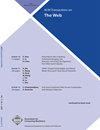Triangle-oriented Community Detection considering Node Features and Network Topology
IF 4.1
4区 计算机科学
Q2 COMPUTER SCIENCE, INFORMATION SYSTEMS
引用次数: 0
Abstract
The joint use of node features and network topology to detect communities is called community detection in attributed networks. Most of the existing work along this line has been carried out through objective function optimization and has proposed numerous approaches. However, they tend to focus only on lower-order details, i.e., capture node features and network topology from node and edge views, and purely seek a higher degree of optimization to guarantee the quality of the found communities, which exacerbates unbalanced communities and free-rider effect. To further clarify and reveal the intrinsic nature of networks, we conduct triangle-oriented community detection considering node features and network topology. Specifically, we first introduce a triangle-based quality metric to preserve higher-order details of node features and network topology, and then formulate so-called two-level constraints to encode lower-order details of node features and network topology. Finally, we develop a local search framework based on optimizing our objective function consisting of the proposed quality metric and two-level constraints to achieve both non-overlapping and overlapping community detection in attributed networks. Extensive experiments demonstrate the effectiveness and efficiency of our framework and its potential in alleviating unbalanced communities and free-rider effect.考虑节点特征和网络拓扑的面向三角形的社区检测
在属性网络中,联合利用节点特征和网络拓扑结构来检测社区被称为社区检测。这方面的大部分现有工作都是通过目标函数优化进行的,并提出了许多方法。然而,他们往往只关注低阶细节,即从节点和边缘视图中捕捉节点特征和网络拓扑,单纯寻求更高程度的优化来保证所发现社区的质量,从而加剧了社区的不平衡和搭便车效应。为了进一步阐明和揭示网络的内在本质,我们考虑节点特征和网络拓扑进行面向三角形的社区检测。具体来说,我们首先引入基于三角形的质量度量来保留节点特征和网络拓扑的高阶细节,然后制定所谓的两级约束来编码节点特征和网络拓扑的低阶细节。最后,我们开发了一个基于优化目标函数的局部搜索框架,该目标函数由提出的质量度量和两级约束组成,以实现属性网络中的非重叠和重叠社区检测。广泛的实验证明了我们的框架的有效性和效率,以及它在缓解不平衡社区和搭便车效应方面的潜力。
本文章由计算机程序翻译,如有差异,请以英文原文为准。
求助全文
约1分钟内获得全文
求助全文
来源期刊

ACM Transactions on the Web
工程技术-计算机:软件工程
CiteScore
4.90
自引率
0.00%
发文量
26
审稿时长
7.5 months
期刊介绍:
Transactions on the Web (TWEB) is a journal publishing refereed articles reporting the results of research on Web content, applications, use, and related enabling technologies. Topics in the scope of TWEB include but are not limited to the following: Browsers and Web Interfaces; Electronic Commerce; Electronic Publishing; Hypertext and Hypermedia; Semantic Web; Web Engineering; Web Services; and Service-Oriented Computing XML.
In addition, papers addressing the intersection of the following broader technologies with the Web are also in scope: Accessibility; Business Services Education; Knowledge Management and Representation; Mobility and pervasive computing; Performance and scalability; Recommender systems; Searching, Indexing, Classification, Retrieval and Querying, Data Mining and Analysis; Security and Privacy; and User Interfaces.
Papers discussing specific Web technologies, applications, content generation and management and use are within scope. Also, papers describing novel applications of the web as well as papers on the underlying technologies are welcome.
 求助内容:
求助内容: 应助结果提醒方式:
应助结果提醒方式:


